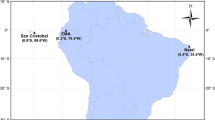Abstract
Arctic ozone is important to the Arctic climate and environment system. Studying the ozone distribution and variation is helpful for understanding the Arctic climate and environment and their impact on the global system, and for numerically forecasting climate and environment change. The Chinese Arctic Research Expedition 1999 made an ozone observation program possible over the Chukchi Sea in the Arctic Ocean. Ozone soundings on board the Chinese icebreaker “ Xuelong” (at 75°N, 160°W, 18-24 August 1999) made high-resolution vertical atmospheric structure and ozone distribution data available for studying ozone variation on a synoptic scale. Analysis of the observational data, the TOMS total ozone, and NCEP circulation, shows that the atmospheric ozone amount experienced a high-low-high variation with low-high-low tropopause altitude. The study shows a close relationship between the total ozone and the ozone below 13 km, while the variation in the maximum concentration at about 20 km does not show any relationship to the column ozone. A weak-strong-weak southwesterly pattern in the 500 hPa synoptic system may be responsible for a low ozone advection during this ozone variation.
Similar content being viewed by others
References
Chinese Academy of Sciences, 2000: Scientific Report, Science Press, Beijing.
National Polar Administration of China, 1999: Project plan of the first Chinese Arctic Expedition, State Marine Bureau, Beijing.
Orsolini, Y., D. Cariolle, and M. Deque, 1995: Ridge formation in the lower stratosphere and its influence on ozone transportation: A general circulation model study during late January 1992. J. Geophys. Res., 100(D6), 11113–11135.
State Marine Bureau, 1999: Operating Plan of Arctic Research Expedition, Beijing (in Chinese).
Steinbrecht, W., H. Claude, U. Kohler, and K. P. Hoinka, 1998: Correlations between tropopause height and total ozone: Implications for long-term changes. J. Geophys. Res., 3(D15), 19183–19192.
Stroh, F., and coauthors, 2001: Balloon borne measurements of CIO, H2O, O3, and tracers during THESEO 2000: Modeled and observed chlorine activation and dehydration, European Geophysical Society XXVI General Assembly, Nice, France, 25–30 March.
WMO / UNEP, 1990: Climate change. The IPCC scientific assessment, Cambridge University Press.
WMO, 1991: Scientific concept of the Arctic climate system study (ACSYS), Report of the JSC study group on ACSYS, Bremerhaven, Germany, 10-20 June 1991 and London, U. K., 18-19 November.
Zou, H., W. Wang, and L. Zhou, 1999: Project summary of Arctic upper-air observation 1999, Institute of Atmospheric Physics, Chinese Academy of Sciences.
Author information
Authors and Affiliations
Rights and permissions
About this article
Cite this article
Han, Z., Libo, Z., Yongxiao, J. et al. An observational study on the vertical distribution and synoptic variation of ozone in the arctic. Adv. Atmos. Sci. 19, 855–862 (2002). https://doi.org/10.1007/s00376-002-0050-8
Received:
Revised:
Issue Date:
DOI: https://doi.org/10.1007/s00376-002-0050-8




